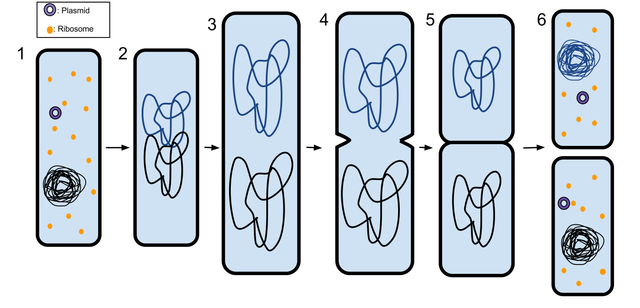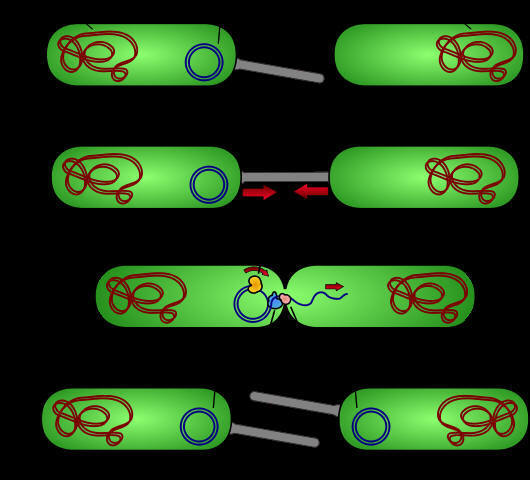Reproduction
Binary
Fission
Binary fission is an asexual
reproduction
process used by prokaryotes. Before binary fission occurs, the
DNA in the cell tightly coils up.
 Next,
the DNA in the cell replicates then the DNA is pulled to
separate poles to prepare for the splitting of the cell. A new
cell wall then starts to grow which in turn starts to separate
the Shigella. Then the new cell wall develops
completely and the Shigella cells are completely split.
The new cells have tightly coiled DNA,
ribosomes, and
plasmids. The diagram above depicts the process of binary
fission.
Next,
the DNA in the cell replicates then the DNA is pulled to
separate poles to prepare for the splitting of the cell. A new
cell wall then starts to grow which in turn starts to separate
the Shigella. Then the new cell wall develops
completely and the Shigella cells are completely split.
The new cells have tightly coiled DNA,
ribosomes, and
plasmids. The diagram above depicts the process of binary
fission.
Conjugation
Shigella sonnei transfers DNA by a
process called conjugation. Conjugation facilitates transfer of DNA
from a donor to recipient.
 Conjugation occurs when bacteria is
passed through two joined prokaryotes. DNA moves from one cell to
another but it can only move one way. The donor cell is the cell
that starts with the DNA which is called
the F factor. The receiver cell is the cell that receives the DNA
from the donor cell but the receiver cell cannot already contain F
factor otherwise the process will not work. Shigella cells will pass
DNA through a sex pilus. The sex pilus joins the two cells together
and pulls the cells very close together for the DNA transfer in the
cytoplasm.
DNA polymerase is synthesized then the DNA will move through the
sex pilus from the donor cell to the receiver cell.
Conjugation occurs when bacteria is
passed through two joined prokaryotes. DNA moves from one cell to
another but it can only move one way. The donor cell is the cell
that starts with the DNA which is called
the F factor. The receiver cell is the cell that receives the DNA
from the donor cell but the receiver cell cannot already contain F
factor otherwise the process will not work. Shigella cells will pass
DNA through a sex pilus. The sex pilus joins the two cells together
and pulls the cells very close together for the DNA transfer in the
cytoplasm.
DNA polymerase is synthesized then the DNA will move through the
sex pilus from the donor cell to the receiver cell.
Positive and Negative Factors of Conjugation
The genetic
transfer is beneficial to Shigella sonnei because it
generates genetic recombination which then can be beneficial for
antibiotic resistance and tolerance to chemicals. The only negative
factor of conjugation is not all bacteria can create sex pili but sex pili can form between many
different bacterial species.
all bacteria can create sex pili but sex pili can form between many
different bacterial species.
Infection of the Cells
All reproduction by Shigella sonnei
is done when this bacteria enters the human intestine tract. It
takes as few as 100 Shigella sonnei cells to start the
infection within the human body. Once more of these bacteria cells
are made, the infection starts to take effect on the
body, which is only a matter of a day or two. The picture to the
right depicts when the two sex pili come together and the donor is
giving the receiver DNA.
Now that you know how Shigella sonnei reproduces, you
should check out how this infection actually interacts with your
body! GO!
Previous
Home
Next
